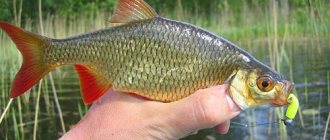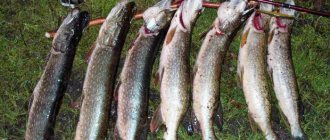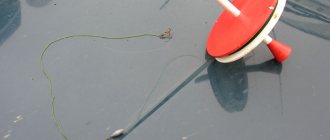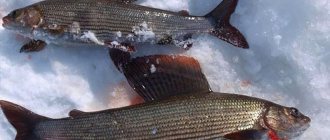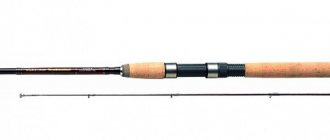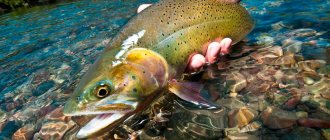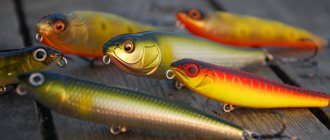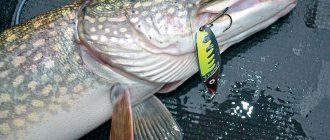In recent years, medium spinning baits have yielded much less catch compared to large ones, while the latter increased the chance of catching something more impressive. As a result, a “heavy” arsenal of spinners, rubber, and wobblers was assembled, into which newfangled jerkbaits organically fit in.
- Casting distance
Catchable spinning lures
The most common spinners in use are numbers four and five, and I’ve practically given up the smaller threes, although I used to catch a lot of them with ones and twos. Vibrators in a box 10-12 cm long.
Among rubber, my favorite ripper (twisters somehow didn’t work) is “hoof” No. 4, that is, about 12.5 cm long. I also use the fifth “hoof”, almost 15 cm, except for pike, perch easily swallows it with 250 grams, and usually with first casts.
As for wobblers, I looked more and more closely at the large ones that trollers use. I liked casting with the iconic Rapalovsky “supershadrape”, its length is 14 cm, its weight is solid, when trolling it reaches depths of 4 meters or more without any problems, but I cast it in meter-long lake shallows.
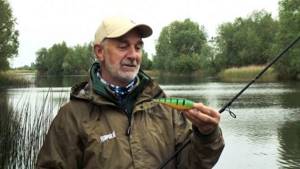
Rapala Super Shad Rap
The wobbler is floating, it is easy to guide it with a step, making it possible to float up during pauses without plowing up the bottom soil.
Jerking Technique Basics
Rules for using jerks:
- Floating jerks are used at depths from 0.5 to 3 m;
- Sinking - from 2 to 5 m.
Step-by-step instruction:
- Let's cast.
- Using smooth pull-ups we deepen the jerk (the number of pull-ups depends on the depth of the reservoir, for example, a diving depth of about a meter requires 2-3 pull-ups). Also, the maximum depth of the bait can be achieved by working the tackle with movements from hip level to the water surface.
- After sinking, allow the bait to surface.
- If this is an algae area, then you need to bring the jerk out of the grass or along its surface - lift the tip of the spinning rod up, further increasing the immersion - lower the tip towards the water.
The behavior of the jerk in the water at this time: dives, floats up, sways to the sides, at the moment of a pause - rolls from one side to the other, hangs with its head up.
If the depth is 2 m or more, sinking jerks are used. In this case, the behavior of a sinking bait will differ from a floating one: it will abruptly slide forward, and when there is a pause, it will roll from side to side and slowly begin to sink.
In the case of fishing from a boat, but not far from the shore, where under the boat there is a sharp drop in the bottom from a shallow to a deep area of 4-5 m, then you only need to use a sinking jerk.
Next you should proceed as follows:
- Make a cast.
- Wait for the bait to deepen to the desired level.
- Start with smooth and slow pull-ups of the bait with short pauses, during which the jerk will sink slightly.
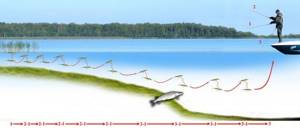
Advice:
- with all wiring methods, you need to monitor the tension of the fishing line;
- monitor the synchronization of the operation of the reel and gear;
- Smooth twitching of the tip of the spinning rod is best done with your hand.
Useful video about jerking fishing (by Zatonfish)
2.1 Jerking in the current
The bait is cast perpendicular to the current. After which the water removes the jerk and thereby tightens the line that sagged during casting. At the moment of tensioning the fishing line, you need to reel it in and make jerking movements with the tackle. You can simply reel in smoothly, letting the current determine the jerk’s play, or you can use the bait to play in the same place, turning the current into your ally, who will constantly return it to the starting point.
2.2 Jerking in calm water
The principle of wiring under such conditions comes down to smooth pulling of the fishing line. The bait should always be in a tense position and remind future prey that in front of it is a weak (wounded) fish.
For beginners, it is better to practice in clear water to understand and see how the bait works when jerking.
Important! A small and elongated bait requires frequent but not strong jerks, with a pull of no more than 20 cm before the next pause. Large jerks require that jerks be infrequent and the retrieve be long.
Jerkbait
Based on my own experience, I came to the conclusion that if there is no powerful gear that can withstand increased loads, then there is no point in using very heavy baits. At the same time, I read a lot about jerky, something sparkled in my head - why not try it?!
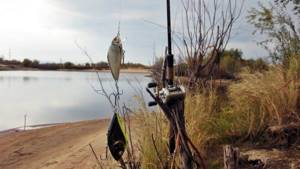
I've been catching it closely for the last few seasons - the results are, in principle, encouraging. But I also keep what I have learned from other baits at hand. After all, large baits do not replace, but perfectly complement medium and small ones. Accordingly, I take two spinning rods with me into the boat. One with a test weight of up to 45, on a spool with 0.17 mm braid - for rubber and spinners. The second spinning rod with a powerful multiplier reel is for heavy jerks with a length of 12-18 cm and a weight of 35 to 95 g.
There was another stick for the jerk theme with a test of 40-80 g, 1.8 m long. While I was fishing with lures up to 50 g, the rod worked normally, was able to give the bait flight at the required distance and did not fail when retrieving. But as soon as I started using jerkbaits weighing 70-80 g, the rod sank during jerks and did not give a clear game. I realized that it wouldn’t hurt to have a supply of dough in jerk fishing and bought a rod with 60-120 g of dough. It won’t work as a universal rod for spinning fishing; it’s too oaky for other lake lures, but it’s okay for jerking.
For jerk fishing, 0.22 mm braid worked fine, but I want to try 0.3 mm, because it’s a pity to lose expensive baits on snags. At the same time, a thicker line will not in any way affect the performance of heavy large jerkbaits, only the depth of the retrieve will be slightly reduced. It’s just a pity that now it’s not easy to find good braided fabric of decent quality. In large diameters there is mainly one piece of junk, unsuitable for such spinning casting fishing.
Features of jerk fishing
So what did jerk give me? Already on the first fishing trip, he gave me hope - while retrieving the bait, a seagull swooped down on the bait, turning away from the water about half a meter away. I heard before that if waterfowl attack a shallow-moving spinning bait, then this is a big plus, which means that it quite accurately imitates the movements of a live fish. On the next fishing trip, where mostly pike up to 1.5 kg were caught, we managed to seduce the “mother” under 5 kg.
Having caught several seasons, I can draw certain conclusions. Basically, my tests took place on shallow natural lakes: the main fishing depth is 1.5-2 m, in some areas about 3 m, full of grass and snags.
I fished from a boat, actively searching for promising points in a vast water area. Lately I prefer not to use an anchor at all; I fish while drifting, unless of course the wind is not strong.
What is a jerkbait
Novice fishermen will not be able to distinguish jerkbaits for pike from wobblers on their own; at the very beginning, many lures seem very similar. However, they will differ radically. Jerk has the following features:
- The weight of the bait starts from 30 g, but the maximum can reach 140 g;
- The jerkbait does not have a shovel; it sinks into the water due to its heavy weight;
- minimum size 10 cm.
Important! Such indicators indicate that it is necessary to use these baits in reservoirs with sufficient depths.
There are several types of pike jerks:
| subspecies | characteristics |
| gliders | a bait without a shovel with a high and voluminous body, thanks to such indicators, with correctly selected wiring, it moves jerkily from side to side |
| pullbaits | there is no shovel; when inserted, it is immersed to the depth specified by the manufacturer |
| divers | a large type of bait that will not play with even wiring is often additionally equipped with propellers in the rear |
| twitchbaits | They play well with monotonous retrieves, but with jerky retrieves they will perform better with a small blade |
Jerk fishing is designed to catch pike from 700 g and more, so it is necessary to form the tackle from good quality components.

Pike on jerk
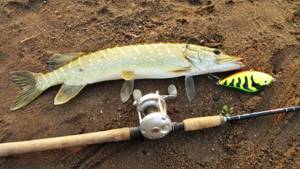
I won’t say that jerks were an order of magnitude more effective than other baits on all fishing trips. There were times when I was fishing with my jerkbaits until the last minute, trying to catch at least one tail, but there were no bites. It happened more than once that the pike followed the jerk, not daring to attack, and eventually turned around and went about its business. At the same time, fishermen I knew were catching some very good pike. However, I remember with pleasure the days when the predator took only jerky baits, completely rejecting all other deceptions.
I already remembered about larger fish, although this point is not so clear - always and everywhere jerkbaits are not able to sift out the big ones from the small ones. It happened more than once that even the largest wobblers were caught by small predatory fish. Once on a jerk of 15 cm, a pike landed about 20 centimeters, and actively attacked like that!
But still, the chance to take a major trophy is much greater, and it seems that not only because of the large size of the jerk, but also because of the peculiarities of his game. Although the size, of course, matters - when gutting lake pikes, I mainly found not fry, but roaches and perches of about 100-150 grams. So my jerks imitate exactly this kind of fish in size, and the largest one (18 cm) is visually very similar to a perch weighing about 200 grams.
Casting distance
I really liked the casting range of heavy jerks. Despite their large size and inevitable windage, these wobblers fly wonderfully, breaking through any wind.
I remember one joint fishing trip with my friend, an avid spinning fisherman. He prefers to fish only with rubber, and on the pond he took a position so that he could cast almost into the wind, which greatly added to the range of the throw. I started throwing against the wind towards my partner. Then we figured it out – our casting ranges were the same.
So with a jerk, the wind, in principle, is not a hindrance; I can throw it wherever I want without any problems. What is very important when fishing in windy weather in shallow waters, when fishing conditions provoke the use of light rubber and spoons (so as not to plow the bottom), here the flight advantages of a jerkbait are very significant.
Jerk picks up a pike from afar
It is also good because it allows you to quickly explore the selected sector, actively fishing large areas of water. If you take a semicircle near the boat, then four casts in different directions are enough.
I’ll go through a very interesting place twice – often the pike takes it on the second retrieve, but there were never any bites on the third trip. Apparently, the pike actually jerks from a decent distance, which makes fishing faster and easier.
But there is a feeling that these exits only happen when the bait is approximately in the same horizon where the predator is standing. And I didn’t notice that a high-reaching jerk lifted pike from decent depths, as is often written on the Internet and in various fishing magazines. And in general, other surface baits, the same poppers, just don’t work for me. There were perches, but the pike were small, rarely more than a kilogram.
It is quite possible that this is a specific feature of shallow lakes, where I fish most, where the pike presses to the bottom and does not particularly want to show itself off by hunting. So you have to drive the jerkbaits closer to the bottom.
When fishing near cramps, this is fraught - an expensive bait can easily be lost even with the thickest braid. The hooks are very strong, thick, it is problematic to straighten them, and a sad dilemma arises: either dive for the bait yourself, or cut the braid with a knife. That’s why I don’t fish with jerks in especially “strong” places - I switch to rubber, which is not so bad to tear off, and you can easily get a pike. But, still, not always.
I remember an indicative case when, in addition to the effectiveness of the jerk, I was once again surprised by the variety of pike attacks.
One cloudy day in late autumn, I sat with a friend on the shore of a lake and had lunch. And then the pike suddenly went hunting - the fry scared off, saw us and hid under a snag, there are a lot of them lying there. A friend immediately grabbed a spinning rod, went to iron the water surface with rubber, worked everything, including the points near the snags, but the pike didn’t take it. Soon, as one would expect, the ripper caught a piece of wood. I told him not to unhook it yet, not to scare the fish, I’ll try to take it with a jerk.
I made two trips around the area where the pike showed up - nothing. The third time I lead a little to the side, literally a couple of jerks with pauses, and a rapid attack follows right before our eyes! The pike circled the bait in an arc and attacked it... from above - you had to see it! The predator weighed 3.6 kg.
Features of jerky fishing
Jerkbaits are all-season baits that can be used anywhere, regardless of the weather or time of year. The main condition is the presence in the selected body of water of a predator ready to attack the proposed object. Pike weighing two kilograms and more are often caught on jerky, and trophy specimens are often caught.
Catching pike with jerky in the spring is advisable in closed reservoirs, in their shallow areas. The predator comes here to spawn, and after laying eggs, it does not immediately leave the chosen place, remaining there for a short time. On rivers during this period, jerks show weak results, and begin to work stably only by mid-May.
From this period the next stage begins - catching pike with jerky in the summer. At this time, you can successfully hunt for spotted beasts with jerkbaits in reservoirs, rivers and large lakes. Many quarries and toad beds are fairly overgrown with aquatic vegetation and it is not always possible to move the bait without getting caught.
Catching pike in the fall with a jerky is the most productive time for fishing for trophy specimens. With their help, you can effectively fish all promising points. These baits work great in shallow water and also lift predators well from the bottom in deep areas.
In toad grasses, swamps, and peat quarries, fishing for pike with a jerkbait in October is very promising. The algae die off, sink to the bottom, and huge spaces open up for the fisherman. With a skillful approach at this time, you can catch much more predators in such reservoirs than in rivers or reservoirs. This fact is known to some seasoned spinning pike anglers and they use this short period productively.
At the end of autumn, the predator slides down to deep riverbed areas closer to wintering pits, where roach, bream, silver bream and other peaceful fish, which form the basis of the diet of the toothy beast, are concentrated in abundance. As a result, catching pike in November with spinning rods and jerkbaits is not always effective, since it is not possible to lure it from the bottom, forcing it to grab the bait. Therefore, it is more advisable to use a jig. Read how to catch pike with a jig here.
Jerky for pike
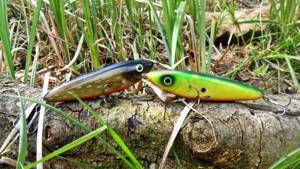
Of all the classes of jerkbaits, I liked fishing most with gliders, which operate smoothly in both horizontal and vertical planes. In terms of colors, I like natural colors the most; they get more bites. And although I don’t strive for a wide variety of colors, I try to have the same model in natural and bright colors. My main emphasis is on the possibilities of placing wobblers at a particular depth.
In summer, pike were keenly interested in active jerking. You drive it with a quick drive, and it does all sorts of things, jumping left and right, but this is a purely summer option.
With the autumn cooling of the water, the predator did not react to active tricks, preferring jerk with slow, smooth, measured, uniform movements. This period began with the passing of the last warm days of Indian summer and became especially evident in the pre-winter period.
— Jerk is a near-surface bait, it doesn’t work at depth
For many, the concept of “jerkbait” is primarily associated with glider-type lures. And most popular glider models are almost impossible to drive to a depth of more than one and a half meters for one simple reason - they are floating. However, we should not forget that there are sinking models, as well as divers, which were specifically created for such fishing conditions. And with such models you can fish very effectively at depths of 3 - 5 m. And a small number of “bulldog” or “twitchbait” models, with some skill, can be made to go deeper to 7 and even 9 m.
In addition, a voluminous jerk with an active “game” creates significant vibrations in the water - and easily lifts the predator to the surface from depths of 3, 5 and even 7 m. In this case, the attack occurs in the place where, say, a heavy one folded a few minutes ago jig.
Jerk casting
It is important to talk about the difficulties that you may encounter when mastering jerks. It is reckless to blindly follow the recommendations of professionals. I have a regular PVC rowing boat without a sling, so I can’t fish standing up, as jerk technology requires. But in practice it turned out that it is more convenient to work while sitting on a board - a seat.
The second question is: in what plane should you work with the rod? Recommended in vertical position. But I can’t do anything at all - the brush somehow bends unnaturally, it’s uncomfortable to hold the tackle in your hands. But when jerking to the side, as in standard twitching, jerks are obtained much better than in the classical scheme.
At first, the problem of casting arose - the baits were heavy, the spinning rod was unusually short, so I switched to a multiplier reel, which I had never tried before. It took about two hours to master the cartoon on short casts. Still the same amount of time to get the hang of throwing 30 meters accurately enough to more or less hit the point where you want.
That is, it took very little time to master the cartoon, yet the experience of inertia-free casting turned out to be useful. Those fishermen who caught the Nevskaya will probably master the multiplier immediately.
Below is a video that demonstrates the technique of casting with a baitcasting reel.
Equipment for pike fishing with jerkbaits (jerkbaits)
Spinning rod for fishing with jerkbaits
The length of the spinning rods used depends on which banks you are going to fish on. If fishing will take place by wading, the spinning rod should be as short as possible for ease of retrieval. If the banks are relatively high - small cliffs or lined with concrete slabs - then it is better to take a longer spinning rod than when fishing from a boat in the same conditions.
As a rule, it is more convenient to fish on such banks with a spinning rod about 1.8–2 m long.
Multiplier reels
A more universal option is the classic multiplier - “barrel”. Most often I use this type of reel. If the fishing is carried out with light jerkbaits (Slider 10, Jolly Dancer Jr., etc.), then you can use “soap dishes”. I have two multis for these purposes - Banax Tova 300 and Kaida Vento VT 20. Both of these reels are low in price and, if not overloaded, last quite a long time. The only thing is that the second cartoon requires winding a thinner line than on other reels. For example, Whiplash Pro 0.21 does not fit completely onto the spool, about 70 m. But this cord length is quite enough. I have 0.42–0.45 mm cords wound on the rest of the reels.
Leashes
I use fairly thin 50 lb titanium leaders from American Fishing Wire, 30 cm long. Due to their rigidity and thin thickness, they do not have any negative effect on the behavior of small jerks. Although when I need to draw them deeper, I use BFT titanium leads a little less than a millimeter thick. With them, floating jerks, for example, Salmo Slider 10F, become suspenders, and slow-sinking ones turn into fast-sinking ones.
Jerker wiring
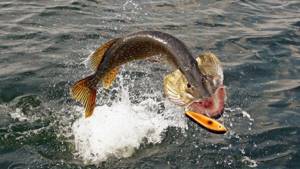
A more important issue is the wiring technique. I suffered a lot here. When jerk is not visible at work, then nothing is clear. Therefore, I tested each individual bait in shallow, clear water. I tried jerks of different strengths and observed how the bait worked.
I knew the theory, I understood what the game should be like, but I have no memory in my hands, they don’t know what leaps to make.
The most serious problem is with the multiplier, which, unlike a conventional “meat grinder,” when removing slack in the fishing line, you twist along a small radius. I had to get used to this with my hand, which tried to twist in a large circle. But pretty quickly the hands began to work in sync, knowing what to do.
After just a few fishing trips, I no longer bothered myself about the technique, just like with the usual bait, I tried to find the place where the predator was standing and feel the bite.
In a strong current it was impossible to catch anything serious - the stream instantly disrupts the play of the voluminous bait. But wandering around the old rivers with jerkbaits is great! In small shallow bays, it is especially good to make lines along a solid wall, luring pikes out of there.
In general, I liked jerky fishing; these lures fit harmoniously into my fishing. Maybe just because I was so interested in them and believed in the capabilities of these large wobblers, I immediately liked them. Still, love at first sight is often stronger than a pragmatic approach.
The best jerk manufacturers
Today, jerk baits are represented on the fishing market by many manufacturers engaged in the development and production of solid bulk baits. Among them there are budget models, and there are famous ones produced under popular brands. Among domestic fishermen, the most popular jerkbaits are individual models from Salmo, T-Rex, and Reaction Strike.
Budget baits are presented by the following manufacturers:
- Strike Pro.
- Raiden.
- Aiko.
- Spro.
Moreover, it is not at all necessary that jerks from these companies will be inferior in performance to more expensive and famous models.
Therefore, we can safely recommend that everyone take a closer look at the products of these brands. Jerkbaits are produced by companies that have earned worldwide recognition in the fishing industry. Among European manufacturers, we can note baits from DAM and AbuGarcia. Interesting models are offered by Japanese Deps and Evergreen.
